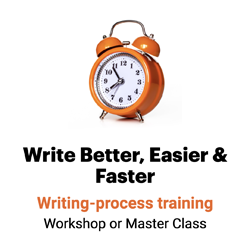Save time, effort when you stop reinventing the wheel
What a great assignment I just completed for a technology comms team: I templated their blog posts, intranet announcements, lead generation emails, news releases, speeches, success stories and white papers.

Now all the writers have to do is to fill in the blanks with their fascinating research and delightful prose. No more reinventing the wheel.
Over the years, I’ve templated everything from event invitations to proposals to webpages for my clients.
Save reading — and writing — time.
I love writing templates because they:
- Save communicators time. Story patterns exist, and a savvy writer can deconstruct them. Instead of reinventing them with each piece, spend your time coming up with brilliant facts and figures and polishing your prose.
- Overcome information overload. Once readers are familiar with the template, they don’t have to learn each subsequent, say, webpage’s structure, write Martin J. Eppler and Jeanne Mengis in “Preparing Messages for Information Overload Environments,” an IABC Research Foundation report. That reduces processing time and effort.
- Result in more effective communications. A group of Israeli researchers found that nine out of 10 award-winning ads used templates; only 2.5% of less successful ads had.
To write better, easier and faster, template your press releases, webpages, proposals, case studies — even your personality profiles. The secret is to develop standard structures that are flexible enough to cover a variety of subjects.
Here are 13 templates to consider:
1. Story tables or grids
Are you comparing X number of items by Y number of characteristics? Make your story a table or grid. Here’s why:
Benefits of story tables |
|
| Tables make stories: | Because they: |
| Shorter | Replace transitions with table cells |
| Easier to read | Are easy to scan and process |
| Easier to write | Use a fill-in-the-cells format |
The Poynter Institute’s Chip Scanlan and The Sun News’ Josh Awtry offer these grid templates — what Autry calls “nonlinear storytelling” — to consider:
Issues roundups. This grid does two things, Scanlan writes. It lays out the information in a logical format for readers, but, almost more importantly, it frees up the communicator’s time and energy to pursue more complex stories.
Issues roundup |
||
| Issue | What’s up | What’s next |
| Issue No. 1 | ||
| Issue No. 2 | ||
| Issue No. 3 | ||
Year in review/preview. Top-stories-of-the year roundups “can get long in a hurry,” Autry writes. Instead, how about creating a simple form where communicators fill in the blanks on key issues of the year?
A year in review/preview |
|||
| News story | What happened | Where it stands | What’s next |
| Story No. 1 | |||
| Story No. 2 | |||
| Story No. 3 | |||
Meeting stories. These are tough. Too often, communicators blah-blah on about who said what in chronological order. “When it’s just a meeting where some things were approved and some action was taken, wouldn’t this information better benefit readers as a grid?” Scanlan asks. I think it would.
Meeting stories |
||||
| Agenda item | Background | What happened | What’s next | Discussion |
| Item No. 1 | ||||
| Item No. 2 | ||||
| Item No. 3 | ||||
Grids are so effective that if a story lends itself to one, I’ll always choose that option.
“Why don’t we, as an industry, embrace different ways of presenting information other than the linear story with a beginning and an end?” Autry wrote. “Why do we take perfectly good information and muddy it up with conjunctions, prepositions, and the like for tradition’s sake?”
2. Lists
Listicles and other list stories make it easy for skimmers to get the gist of the message without doing a deep dive on the topic. No wonder they’re so popular on social media and other platforms.
3. Case studies
For case studies, testimonials — even mini narratives — try this simple structure:
- Problem
- Solution
- Results
4. Web pages
In a recent project, we created templates for some sections of Saint Luke’s Health System’s new website. Department pages, for instance, included:
- Highlights: A bulleted list of our three most compelling differentiators — firsts, mosts, bests, biggests and onlies
- Nut graph: A one-paragraph summary of the department
- The team: Notable players
- Services: A bulleted list
- Learn more: Contacts and links
- Testimonial: A callout from a patient
Your web pages will be different, but you’ll save a lot of time if you’ll develop templates. We’ve templated web pages for Tellabs and PetSmart Charities, as well as Saint Luke’s.
5. Memos
Procter & Gamble uses this one-page memo template:
- Idea
- Background
- How it works
- Key benefits
- Next steps
If a memo at Procter & Gamble exceeds a single page and doesn’t use this format, Eppler and Mingis write, it’s likely to be returned to the writer unread.
6. Project proposals
Procter & Gamble also uses this two-page proposal template:
- Background
- Objective
- Rationale
- Plan
- Open issues and questions to be answered
- Next steps
7. Solutions descriptions
In their IABC Foundation report, Eppler and Mingis themselves demonstrate the power of templates by organizing their solutions pages like this:
- Context: Who’s doing it
- Main idea: Why it works
- Implementation: How to
- Caveat: Issues to avoid
8. Advertising
Most creative ads use one of these six advertising templates, according to a group of Israeli researchers:
- Pictoral analogy: Replace the central image with another one — a croissant for a tennis ball, for instance
- Consequences: Car speakers that are so loud, they make a bridge collapse, say
- Extreme situation: A jeep driving under the snow to demonstrate its all-weather capabilities, maybe
- Competition: A race between a car and a bullet, for instance
- Dimensionality alteration: A woman arguing with her husband about life insurance — in a seance, after he’s died, for example
- Interactive experiment: the Pepsi Challenge, for instance
9. News releases
These elements of the social media release template would make a good template for any release:
- Headline
- Deck
- Introductory paragraph or two
- List of key facts
- List of quotes
10. Personality profiles
The International Association of Business Communicators and Qualcomm and are among the companies that template human interest stories. In fact, all these organizations get profilees to fill in the blanks, so communicators need only edit the profiles.
IABC’s template includes these questions:
- Which word or phrase do you think is overused right now?
- How would you explain your profession to a child?
- What did you have to learn the hard way?
- If you could choose another profession, what would it be?
- What’s the best reward for a job well done?
11. Critical issues memo
Mike Hall, corporate communication manager for Pioneer Hi-Bred Europe, developed this memo template for outlining critical communication issues:
- Situation: What happened?
- Response strategy: How we are dealing with it?
- Media coverage: What are the media writing about it?
- Media strategy: How we will move forward and with whom?
- Standby statement to press: What do we currently release as the corporate view on the issue?
12. SPIN memo
Here’s another way to template a similar message:
- Situation
- Problem
- Implications
- Next steps
13. Narrative structure
Writing an anecdote or story? Eppler and Bischof suggest this structure:
- The (hero’s) context
- A challenge or crisis to overcome
- A failed attempt
- A successful attempt (climax)
- Resolution
- A moral, or lessons learned
Write by number
Words like template, formula and recipe are sometimes seen as profanities in a creative field like writing. But good writing is at least as much science as art. And you can’t argue with results like “easier to read” and “easier to write.”
No doubt about it: T-e-m-p-l-a-t-e is not a four-letter word.
What template could you use for your next piece?
___
Source: Martin J. Eppler and Jeanne Mengis, “Preparing Messages for Information Overload Environments”, IABC Research Foundation, 2009
Chip Scanlan, “Nonlinear Narratives,” The Poynter Institute, Oct. 16, 2003
Josh Awtry, “Grid Tips,” The Poynter Institute, Oct. 15, 2003
Josh Awtry, “‘There just isn’t a story here,’” The Poynter Institute, Oct. 15, 2003

Leave a Reply